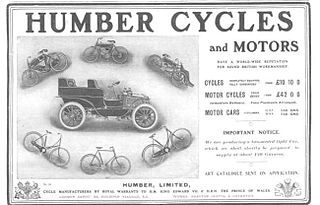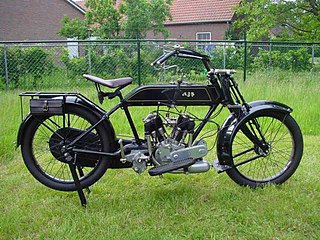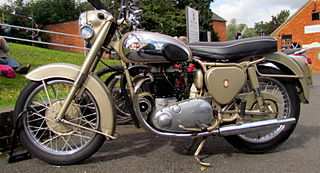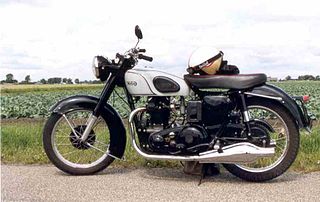
Brough Motorcycles were made by William E. Brough in Nottingham, England, from 1902 to 1926 , after some earlier experimentation with motorised tricycles. [1] The Brough Superior company was a separate company created by his son, George Brough.

Brough Motorcycles were made by William E. Brough in Nottingham, England, from 1902 to 1926 , after some earlier experimentation with motorised tricycles. [1] The Brough Superior company was a separate company created by his son, George Brough.
The first Brough motorcycle was built in 1902, and had a single cylinder engine hung from the downtube. By 1908 there were a range of models with 2.5 hp and 3.5 hp single cylinder and 5 hp V-twin engines (all made by Brough). By 1912 there was a 6 hp V-twin, and an 8 hp engine was also made intended for use in the Brough light car.
In 1913 William Brough developed a flat-twin engine in-line with the frame. This 497cc engine had overhead valves, 70mm bore and 64.5mm stroke, and had a magneto fitted above and a 2-speed gearbox below. By the end of 1914 it had replaced all other engines in the Brough range, and using it only 3-models were planned for 1915. [2] The three models were the HS - which was fitted with a two-speed countershaft gear operated by dog clutches, with chain drive to the gearbox, and John Bull rubber belt drive to the rear wheel over an adjustable pulley allowing the top gear range to be varied. No clutch or kick-start was provided. The second model was the HB, which was fitted with a Sturmey-Archer 3-speed hub gearbox and handle starter. The third model was the HTT, which was very similar to the HS but fitted with a specially tuned engine with high-compression, lightweight steel pistons, different camshafts, and special front cylinder lubrication. [3]
During the war Brough introduced a larger flat-twin of 6 hp rating, with 70mm bore and 90mm stroke (692cc), it shared a lot in common with the earlier 6 hp V-twin. [4]
At the end of 1918, George Brough had been developing his own ideas on the design of his father’s flat twin engine. A new 500cc job .The engine had detachable heads with the valve seats integral and the rockers 'enclosed in neat aluminium cases'. Light aluminium pistons, roller bearing crankshaft, and two ball bearing mounted camshafts.This was bench tested at 14 bhp at 4200rpm, and could go to 5600rpm.George Brough guaranteed it to the sum of £100.
George Brough had been a partner in his father's company. He split from it in 1919,(father William objected to the costs of the new 500cc engine George had been testing, it was all about cost ) and started his own factory on Hadyn Road in Nottingham.The first Brough Superiors were made in the garage of Stockhill Lodge ,on Nuttall Road. Stockhill House was where his father then lived. He named his motorcycles "Brough Superior".
2/2/1919 A friend & drinking crony of George, called 'Bob' Blay purchased a W E Brough. Registration Al 4659 Georges first 90 Bore prototype HP 2122 was made mid 1919. George Brough and Bob Blay propped up the bar in a pub. George after a few beers is saying he really does not know what to call his new machine. Bob, who has recently acquired a W E Brough , chips in, ” I 've got one of your fathers Brough machines and yours is better than that, why not 'Brough Superior'. Robert Blay is also later recorded as the first owner of a Nottingham 1922 Mark I side-valve machine, registration AU 5708
Upon hearing the name of the new motorcycle company, his father was reputed to have made the comment, "I suppose that makes mine the Brough Inferior".
The two sizes of Brough flat-twin engine were still in production in 1922 when Brough announced a modified version with roller cam followers, light aluminium pistons, removable valve seats, and the engine base extended to mount the three-speed Sturmey-Archer gearbox. [5] William Brough continued to produce motorcycles under the original "Brough" marque until 1926.

A flat-twin engine is a two-cylinder internal combustion engine with the cylinders on opposite sides of the crankshaft. The most common type of flat-twin engine is the boxer-twin engine, where both pistons move inwards and outwards at the same time.

Velocette was a range of motorcycles made by Veloce Ltd, in Hall Green, Birmingham, England. One of several motorcycle manufacturers in Birmingham, Velocette was a small, family-owned firm, selling almost as many hand-built motorcycles during its lifetime as the mass-produced machines of the giant BSA and Norton concerns. Renowned for the quality of its products, the company was "always in the picture" in international motorcycle racing from the mid-1920s until the 1950s, culminating in two World Championship titles and its legendary and still-unbeaten 24 hours at over 100 mph (161 km/h) record. Veloce, while small, was a great technical innovator and many of its patented designs are commonplace on motorcycles today, including the positive-stop foot shift and swinging arm rear suspension with hydraulic dampers. The business suffered a gradual commercial decline during the late 1960s, eventually closing in February 1971.
Coventry Victor was a British motorcycle and car manufacturer. Originally Morton & Weaver, a proprietary engine manufacturer in Hillfields, Coventry, founded in 1904, the company changed its name to Coventry Victor Motors in 1911. The company closed in 1971.

In automotive engineering a multi-valve or multivalve engine is one where each cylinder has more than two valves. A multi-valve engine has better breathing and may be able to operate at higher revolutions per minute (RPM) than a two-valve engine, delivering more power.

Brough Superior motorcycles, sidecars, and motor cars were made by George Brough in his Brough Superior works on Haydn Road in Nottingham, England, from 1919 to 1940. The motorcycles were dubbed the "Rolls-Royce of Motorcycles" by H. D. Teague of The Motor Cycle newspaper. Approximately 3048 motorcycles were made in the 21 years of production; around a third of that production still exists. T. E. Lawrence owned eight of these motorcycles and died from injuries sustained when he crashed number seven; the eighth was on order. Moving forward to 2008, vintage motorcycle enthusiast Mark Upham acquired the rights to the Brough Superior name. In 2013 he met motorcycle designer Thierry Henriette and asked him to design a new Brough Superior motorcycle. Three months later a prototype of a new SS100 was shown in Milan.
Wooler was a British manufacturer of motorcycles and automobiles, founded by engineer John Wooler in 1911 based in Alperton, Middlesex. The company became known for its unconventional designs which included several fore-and-aft twins, a vertical camshaft single cylinder machine, a transverse-four beam engine, and a transverse flat four. Most machines possessed Wooler's enduring design features of a petrol tank which extended past the steering head.

The New Hudson Cycle Co. was originally started in 1890 by George Patterson, and manufactured 'safety' bicycles in Birmingham. In 1903 they produced their first motorcycle, but times became tough for Patterson after one of his sons died in WW1 and the other lost a leg. The family sold the factory to HJ Bructon after WW1, and in 1920 the company was reformed as New Hudson Ltd.

The L-twin is a naturally aspirated two-cylinder petrol engine by Ducati. It uses a 90-degree layout and 270-degree firing order and is mounted with one cylinder horizontal.

Douglas was a British motorcycle manufacturer from 1907 to 1957 based in Kingswood, Bristol, owned by the Douglas family, and especially known for its horizontally opposed twin cylinder engined bikes and as manufacturers of speedway machines. The company also built a range of cars between 1913 and 1922.
Blackburne was a trade name of Burney and Blackburne Limited a British manufacturer of motorcycles from 1913 to 1922 at Tongham near Farnham, Surrey. They were also a major supplier of engines to other motor cycle and light car makers and continued to make these until 1937. Burney and Blackburne also made small aircraft engines.

Victoria was a bicycle manufacturer in Nürnberg, Germany that made motorcycles from about 1901 until 1966. It should not be confused with a lesser-known, unrelated Victoria Motorcycle Company in Glasgow, Scotland that made motorcycles between 1902 and 1928.

The Brough Superior SS 100 is a motorcycle which was designed and built by George Brough in Nottingham, England in 1924. Although every bike was designed to meet specific customer requirements—even the handlebars were individually shaped—sixty-nine SS100s were produced in 1925 and at £170 were advertised by Brough as the "Rolls-Royce of Motorcycles". The term was coined by a magazine road tester in his review of the bike, and Brough eventually obtained explicit permission to use it after a Rolls-Royce executive toured the Brough Superior factory. All bikes had a guarantee that they were capable of 100 mph (160 km/h).

Humber Limited was a pioneering British motorcycle manufacturer. Humber produced the first practical motorcycle made in Britain by fitting one of their Humber bicycles with an E. J. Pennington two-horsepower motor in 1896.

The Brough Superior Golden Dream was designed and built by George Brough in Nottingham, England, in 1938. With its distinctive gold finish, this was to be the ultimate Brough Superior but production was stopped by the outbreak of War in 1939.

Quadrant was one of the earliest British motorcycle manufacturers, established in Birmingham in 1901. Famous for their big singles, Quadrant pioneered many innovations that proved important for motorcycle development but struggled after the First World War and the company was wound up in 1928.

The Brough Superior Austin Four was a limited-production motorcycle designed and manufactured by Brough Superior of Nottingham, UK in 1932. It was listed in the 1932 Brough Superior catalogue as the 'Straight Four' but it was commonly known as the Brough Superior Austin Four, or BS4, or '3-wheeled Brough'. The machine is unique in its design, being powered by a modified Austin 7 automobile engine and gearbox unit, from which a driveshaft emerges on the centre-line of the motor. Rather than design a new gearbox, George Brough had the inspiration to keep the central driveshaft, and use a pair of close-couple rear wheels driven by a central final drive box. This 3-wheeled design was legally considered a motorcycle as the wheel centres were within 24". The Brough Superior-Austin Four created a sensation when revealed at the 1931 Olympia Motorcycle Show.

The AJS Model D is a British motorcycle made by A. J. Stevens & Co. Ltd in Wolverhampton between 1912 and 1925. With production halted by the First World War AJS managed to develop the Model D into a popular sidecar machine and it was eventually replaced by the larger capacity AJS Model E.

Their new Daimler 22 horsepower full-size luxury car was first displayed by Daimler in April 1902 at The Automobile Club’s Exhibition in London's Agricultural Hall. Daimler had elected to drop their multiple old low powered designs and restrict themselves to this 22 horsepower and a pair of 9 or 12 horsepower cars to the same design as the 22 but more lightly constructed. The King’s not quite finished new Daimler 22 was reported to be the chief attraction of the show.

The BSA A10 series was a range of 646 cc (39.4 cu in) air-cooled parallel twin motorcycles designed by Bert Hopwood and produced by Birmingham Small Arms Company at Small Heath, Birmingham from 1950 to 1963. The series was succeeded by the A65 unit construction models.

The Norton Model 7 Dominator was a 500 cc vertical twin motorcycle manufactured by the Norton Motorcycle Company from 1949 to 1955. It was the first of Norton's Dominator range of motorcycles. The engine was designed by Bert Hopwood and was a departure from Norton's previous practice of producing single-cylinder machines. The Model 7 was used in Japan as a police motorcycle.